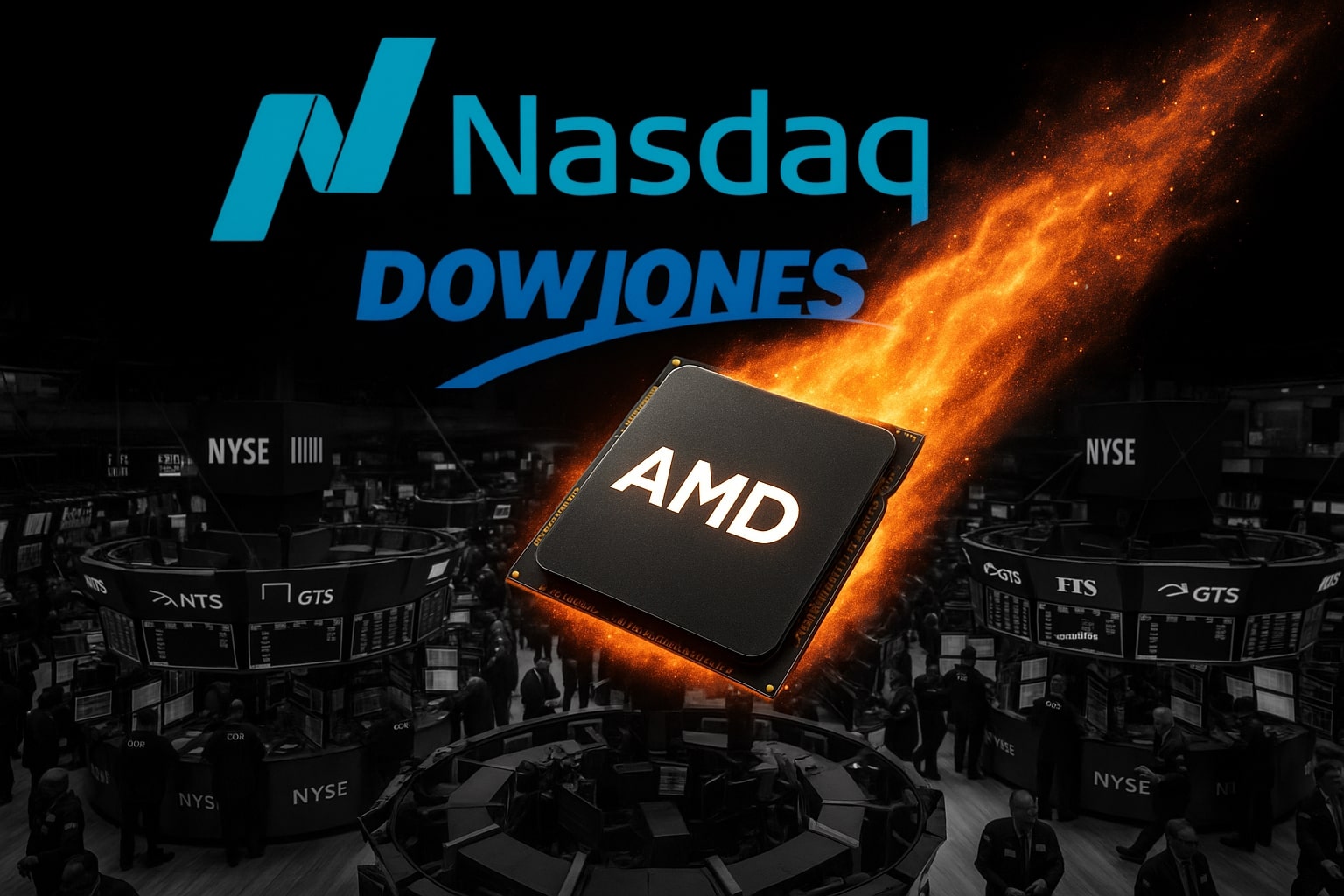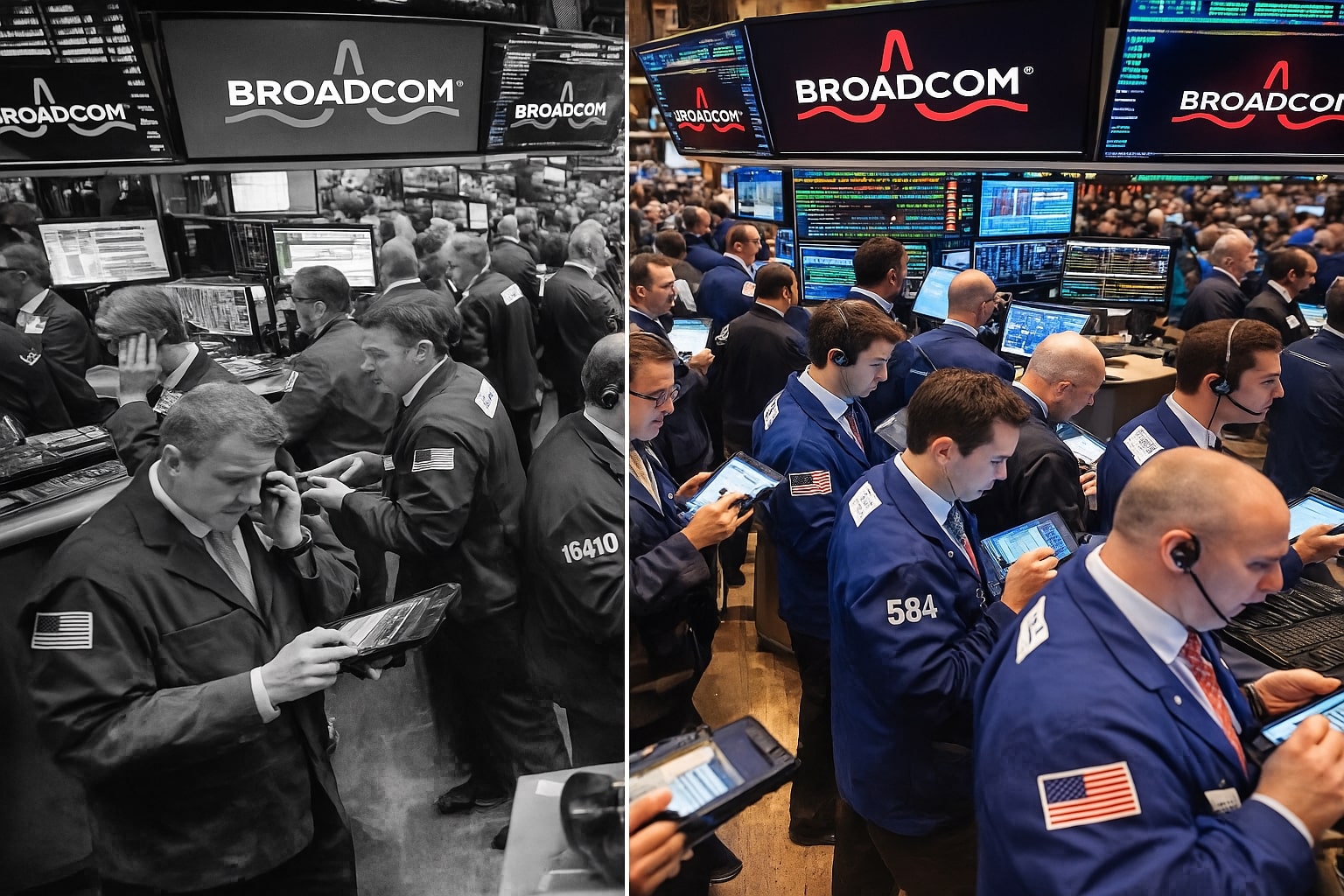
Stock Market Today: Tech and Biotech Power a Cautious Comeback — AMD, Amgen, Nvidia Lead Nasdaq Recovery
S&P 500 climbs 0.49% to 6,804.69, Nasdaq adds 0.78% to 23,529.97 while the Dow inches up 0.09%. Strong ADP payrolls, ISM services data lift yields to 4.15% | That's TradingNEWS
Wall Street Rebounds as Tech and Biotech Anchor a Cautious Recovery
The U.S. stock market stabilized Wednesday after a volatile session that followed a deep technology-led selloff. The S&P 500 (SPX) climbed 0.49% to 6,804.69, the Nasdaq Composite (COMP) advanced 0.78% to 23,529.97, while the Dow Jones Industrial Average (DJIA) edged up a modest 0.09% to 47,127.87. The Cboe Volatility Index (VIX) eased below 18 as short-term fear retreated. Gains were driven by a rebound in AI chipmakers and large-cap healthcare stocks, though market breadth remained constrained and rising Treasury yields kept pressure on valuations.
Technology Recovers as Advanced Micro Devices Leads Semiconductor Strength
Advanced Micro Devices (NASDAQ: AMD) reversed early declines and finished higher after delivering a strong quarterly report that reignited confidence in the AI infrastructure trade. The chipmaker posted Q3 revenue of $9.25 billion, beating expectations of $8.74 billion, with adjusted earnings per share of $1.20 compared with $1.16 forecast. Revenue from its data-center division surged 22% year-over-year to $4.3 billion, while client and gaming revenue jumped 73% to $4.0 billion, highlighting robust AI-related demand. Guidance for Q4 revenue between $9.3 billion and $9.9 billion surpassed consensus, indicating sustained momentum into year-end. Despite the beat, shares only rose modestly as investors digested Amazon’s disclosure of selling its minor AMD stake and ongoing concerns over stretched AI valuations. Micron Technology (NASDAQ: MU) rallied roughly 8% after a week of losses, supported by expectations that high-bandwidth memory demand tied to AI servers will lift prices in the December quarter. Broadcom (NASDAQ: AVGO) advanced nearly 3%, with traders rotating back into diversified chip names following the sector’s two-day decline, while Nvidia (NASDAQ: NVDA) edged 1.6% higher after a 5% slide Tuesday, holding near $571 and remaining 15% off its October highs. The moves signaled stabilization across the semiconductor complex, though investors remain wary that recent AI enthusiasm has overshot earnings reality.
AI Valuations Tested as Palantir, Super Micro, and Arista Lose Momentum
The speculative corner of the AI market faced renewed scrutiny. Palantir Technologies (NYSE: PLTR) slipped another 2.3% to around $36.80, extending Tuesday’s 8% plunge despite record quarterly results and higher full-year guidance. With the stock trading at more than 200× forward earnings, traders cited valuation exhaustion and a rotation toward hardware-driven AI exposure as key drags. Super Micro Computer (NASDAQ: SMCI) sank 8.6% to $43.34 after reporting fiscal Q1 adjusted EPS of $0.35 on revenue of $5.02 billion, both below Wall Street’s $0.40 and $6.0 billion forecasts. Forward guidance between $0.46–$0.54 EPS missed the expected $0.61, triggering aggressive profit taking. Arista Networks (NYSE: ANET) fell 5% following cautious commentary on enterprise spending and a slowdown in data-center switch orders, reflecting more selective capital allocation across AI infrastructure. Analysts described the current environment as “a re-pricing of hype to earnings reality,” with top-tier names maintaining momentum while high-multiple software and peripheral hardware stocks struggle.
Dow Jones Leadership Shifts to Biotech as Amgen Powers Higher
Among Dow components, Amgen (NASDAQ: AMGN) surged 5.5% to $314.58 after smashing consensus forecasts with Q3 EPS of $5.64 versus $5.01 expected and revenue of $9.56 billion, up 12% year-over-year. The company raised full-year EPS guidance to $20.60–$21.40 and revenue to $35.8–$36.6 billion, emphasizing broad-based volume growth of 14%. CEO Robert Bradway said Amgen’s pipeline in obesity and oncology continues to build long-term value, with weight-loss trial data expected before year-end. The stock’s 20% year-to-date rise now doubles the Dow’s overall gain. McDonald’s (NYSE: MCD) climbed 1.8% to $304.61 after U.S. same-store sales growth of 3.4% topped expectations, offsetting a slight EPS miss of $3.19 versus $3.25. Management acknowledged low-income consumers remain under pressure but pointed to continued digital and delivery expansion supporting profitability. The steady performance from McDonald’s, coupled with Amgen’s breakout, underscores a rotation into cash-generative, defensively positioned blue chips.
Social Media and Retail Sentiment Deteriorate After Weak Guidance from Pinterest and Cava
Pinterest (NYSE: PINS) endured one of its steepest single-day drops in months, plunging 21% to $25.95 after delivering Q3 adjusted EPS of $0.38, missing estimates by four cents despite 17% revenue growth to $1.05 billion. The platform reached 600 million monthly active users, yet guidance for Q4 revenue of $1.31–$1.34 billion disappointed analysts expecting stronger holiday performance. ARPU in the U.S. and Canada rose only 5% to $7.64, while global ARPU stagnated at $1.78, amplifying monetization concerns. Analysts downgraded the stock to Neutral, citing weak North American ad demand. Meanwhile, Cava Group (NASDAQ: CAVA) slid 8% to $51.25 after cutting full-year comparable sales expectations to 3%–4%, down from 4%–6%, attributing the slowdown to reduced visits by younger consumers impacted by student loan repayments. CFO Tricia Tolivar also highlighted that tariff-related uncertainty has hurt discretionary spending. The reaction from both names reflects how unforgiving investors remain toward even modest guidance cuts in an environment of high funding costs and cautious consumption trends.
Axon Enterprises Tumbles Despite Strong Revenue Expansion
The industrial and defense technology space saw steep losses led by Axon Enterprises (NASDAQ: AXON), which collapsed 18% following Q3 revenue of $710.6 million (+31% YoY) but an adjusted EPS of $1.17, far below consensus at $1.49. The company’s announced $625 million acquisition of Carbyne, a cloud-based emergency communication provider, weighed heavily on margins and sparked investor concern over integration costs. Despite this, Axon remains up nearly 19% year-to-date, though sentiment turned sharply after the miss, suggesting the market is prioritizing profitability over growth in the current rate environment.
Macro Data Reinforces U.S. Economic Resilience While Fueling Higher Yields
Economic data injected renewed optimism into the growth outlook but also lifted Treasury yields. The ADP private payrolls report showed 42,000 jobs added in October, surpassing forecasts of 22,000 and reversing a prior-month decline of 29,000. Gains were led by trade, transportation, and health services, signaling resilience despite fiscal disruptions from the prolonged government shutdown. The ISM Services Index climbed to 52.4 in October, above September’s 50.0, with new orders surging to 56.2 and business activity improving to 54.3, both reflecting healthy demand. However, employment stayed in contraction territory at 48.2, and the prices-paid index jumped to 70%, indicating persistent inflationary pressure. In response, Treasury yields moved higher, with the 10-year note (BX:TMUBMUSD10Y) rising 6 basis points to 4.153%, and the 2-year yield advancing to 3.636%, trimming odds of another Fed rate cut in December. Analysts now anticipate a “higher-for-longer” stance if economic data continues surprising to the upside.
Supreme Court Tariff Hearing Adds Policy Uncertainty to Industrial Outlook
Market attention briefly shifted to Washington as the U.S. Supreme Court heard oral arguments regarding former President Donald Trump’s 2020 tariff actions. The justices questioned whether the broad levies, ranging from 10% base rates to as high as 50% on imports from India and Brazil, were legally imposed under the International Emergency Economic Powers Act (IEEPA). The potential ruling could reshape global trade flows and directly affect manufacturers, industrial exporters, and commodity-linked equities that rely on predictable import costs. Although most investors see limited near-term impact, the case injects additional headline risk for multinationals already navigating fragile supply chains.
Breadth Weakens as Russell 2000 Slips Below Trend
The Russell 2000 (RUT) lagged major indices, closing at 2,444.29, below its 50-day moving average of 2,439.82, marking its first extended dip under trend since early August. Small caps remain vulnerable to higher financing costs and slowing domestic demand, and the breakdown in breadth highlights a lack of conviction outside megacap leadership. This divergence reinforces the idea that Wall Street’s rally is increasingly concentrated in a handful of large-cap growth and defensive sectors rather than a broad-based advance.
Read More
-
Palantir Stock Price Forecast - Can a $440B AI Defense Powerhouse Grow Into Its $184.74 Price?
16.12.2025 · TradingNEWS ArchiveStocks
-
XRP Price Forecast - XRP-USD Drops to $1.87 as Whale Dumps $721M While XRP ETFs Quietly Cross $1B
16.12.2025 · TradingNEWS ArchiveCrypto
-
Oil Price Forecast - Oil Slide Hard; WTI CL=F Near $55, Brent BZ=F Below $60 as Market Bets on 2026 Supply Glut
16.12.2025 · TradingNEWS ArchiveCommodities
-
Stock Market Today: Dow (^DJI) 48,404 And S&P 500 (^GSPC) 6,812 Slip As Jobs Hit +64K And AVGO Sells Off
16.12.2025 · TradingNEWS ArchiveMarkets
-
GBP/USD Price Forecast - Pairs at 1.34 as Weak U.S. Jobs Data Clash with BoE Cut Bets into Year-End
16.12.2025 · TradingNEWS ArchiveForex
Sector Rotation Reflects a Split Between Growth and Value
Sector performance painted a mixed picture. Information Technology advanced 0.5% on semiconductor rebounds, while Healthcare climbed 0.9% led by Amgen’s surge. Consumer Discretionary edged 0.4% lower, dragged by Cava and weakness in retail-linked names. Communication Services slumped 2.2% amid Pinterest’s sell-off, while Industrials dropped 0.8% as Axon weighed on sentiment. Energy shares were broadly flat, with West Texas Intermediate crude (CL00) holding at $60.58 per barrel, and Gold futures (GC00) rising 0.7% to $3,986.40 per ounce, approaching the $4,000 threshold. The U.S. Dollar Index hovered near 100.27, showing minimal movement, while Bitcoin (BTC-USD) rebounded to $103,500, up from sub-$99,000 lows Tuesday.
Strategic Market Outlook and Investment Positioning
The session revealed a market balancing renewed earnings optimism against valuation headwinds and macro uncertainty. Roughly 82% of S&P 500 companies reporting so far have beaten expectations, implying resilient corporate health, yet stretched price-to-earnings multiples and narrow breadth limit sustained upside. Investors are shifting toward companies with consistent earnings delivery and defensive growth, while trimming exposure to speculative AI and consumer discretionary stocks. Rising term premiums in bonds are capping multiple expansion across growth sectors, suggesting the S&P 500 may consolidate between 6,700 and 6,900 unless yields retreat or the Federal Reserve hints at additional easing.
Stock Verdicts and Tactical Stance
AMD (AMD) – Buy: solid guidance, strong data-center growth, structural AI leader.
NVDA (NVDA) – Hold: core to AI ecosystem but valuation elevated.
MU (MU) – Buy: cyclical rebound tied to AI memory demand.
AMGN (AMGN) – Buy: raised outlook, defensive growth profile, pipeline catalysts.
MCD (MCD) – Hold: stable revenue mix, margin resilience despite consumer pressure.
PLTR (PLTR) – Sell: excessive valuation, momentum fading.
SMCI (SMCI) – Sell: guidance miss, post-earnings risk.
ANET (ANET) – Hold: fundamental strength but softening orders.
PINS (PINS) – Sell: monetization weakness, poor visibility.
CAVA (CAVA) – Sell: demographic-driven softness, margin risk.
AXON (AXON) – Sell/Hold: high growth offset by integration drag.
AVGO (AVGO) – Hold: balanced exposure, steady ahead of results.
Overall Market Tone
Wednesday’s rebound reflected selective optimism rather than broad risk appetite. The resilience of semiconductor earnings and biotech leadership contrasts with faltering software, small-cap, and consumer names. The combination of sturdy U.S. data, higher Treasury yields, and narrow participation suggests the market is transitioning from euphoria to selectivity. Traders remain buyers of strength in quality large caps, but caution prevails across overvalued corners of the AI trade. Unless inflation data or policy catalysts shift expectations before year-end, the equity rally is likely to remain range-bound and rotational rather than explosive.


















